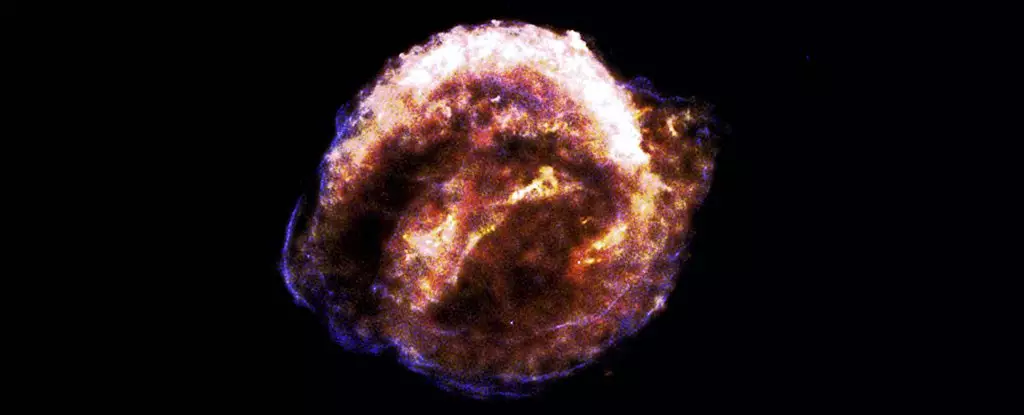Supernovae, the cataclysmic explosions marking the death of massive stars, do more than mere fireworks in the vastness of space; they play a crucial role in the formation of heavy elements. Within these monumental events, elements like iron are created and ejected into the cosmos, seeding the universe with the building blocks of life. On Earth, this process has left a significant mark: two identified surges of the iron isotope Fe60 found in ancient seafloor sediments, dating back two to three million years and five to six million years ago. These findings illustrate not just a moment of cosmic creation, but a narrative connecting the lifecycle of stars to terrestrial existence.
Linking Cosmic Events to Earth’s Biological History
In research presented in the Astrophysical Journal Letters, scientists delve into the implications of these cosmic events on Earth and how they might have influenced life. The study, led by Caitlyn Nojiri of UC Santa Cruz, posits a compelling case for the connection between supernovae and the evolution of life. The researchers highlight the constant presence of radiation—both from natural terrestrial sources and outer space. While terrestrial radiation has diminished over billions of years, cosmic radiation fluctuates as our Solar System traverses the galaxy.
Nearby supernovae can dramatically elevate radiation levels on Earth, potentially profoundly impacting evolutionary trajectories. The paper specifically identifies two primary epochs of Fe60 accumulation tied to supernova activity: one occurring alongside Earth’s transit into a cosmic bubble generated by massive OB stars and the other closely linked to a more recent supernova explosion.
Understanding the Local Bubble and Its Significance
The Local Bubble, a region of hot gas about 1,000 light-years in diameter, has been identified as a product of multiple supernovae that have occurred over millions of years. Research indicates that at least nine supernova explosions have unfolded in the past six million years to create this dynamic cosmic environment. This bubble serves not only as an interesting feature of our solar system’s locality but also as a historical ledger narrating the climatic and biological shifts on Earth. As the Solar System ventured into this bubble roughly five to six million years ago, the implications for life became more pronounced.
Currently, understanding how the increased radiation levels influenced biological systems presents a stirring scientific frontier. While there is consensus around the potential for increased mutation rates due to radiation exposure, the severity and implications of such mutations remain uncertain. Essentially, the possibility exists that significant radiation doses from these cosmic events may have induced critical biological changes, potentially influencing speciation.
The interplay between radiation and biological evolution invites intriguing hypotheses. Researchers speculate that radiation from supernovae could cause double-strand breaks in DNA—a form of damage that can initiate chromosomal alterations and even result in cell mortality. Critically, these alterations can lead to mutations, serving as a catalyst for diversification among species. Recent studies exploring viral evolution in ecosystems, such as the African Tanganyika Lake, reveal an acceleration in species diversification correlating with periods of increased cosmic radiation exposure.
While the connection between increased mutation rates and supernova activity remains speculative, the framework supports a larger narrative attributing a role to cosmic phenomena in shaping biodiversity on Earth.
As researchers explore the dichotomy of radiation’s impact, questions arise regarding its role as either an environmental detriment or a potential mechanism for fostering complexity in life. Elevated radiation may not have caused mass extinctions, but it might have driven the diversification of life forms during critical evolutionary periods. This intrinsic link between cosmic radiation and biological evolution highlights the importance of disentangling harmful effects from beneficial changes.
Despite ongoing studies, we still lack a complete understanding of how varying levels of radiation affect biological systems. The threshold at which radiation transitions from being a catalyst for evolution to a harbinger of danger remains largely enigmatic. The current knowledge base underscores that as cosmic environments shift, so too do the external pressures faced by living organisms.
As we probe the depths of our cosmic origins and their ramifications on life on Earth, the evidence becomes compelling that supernovae are not mere celestial events but foundational forces in our planet’s history. They underscore a cosmic narrative that connects the lives of multi-cellular organisms right down to the intricacies of cellular biology. As we continue to unravel these cosmic threads, we may yet discover that our existence is woven through the fabric of the universe, linking us to the stars that preceded us. Without the cataclysmic power of supernovae, the evolutionary path that led to the rich tapestry of life we experience today could have taken an entirely different course.


Leave a Reply